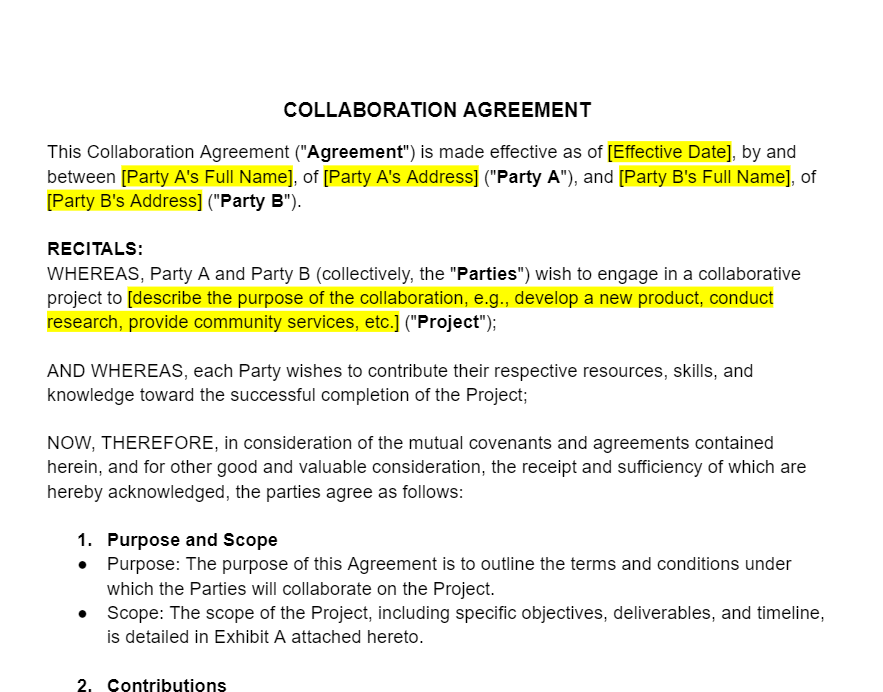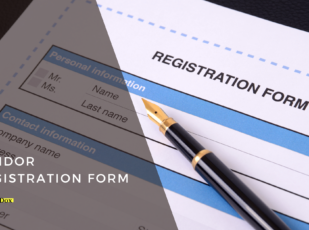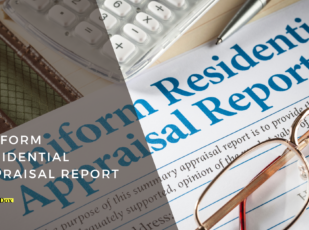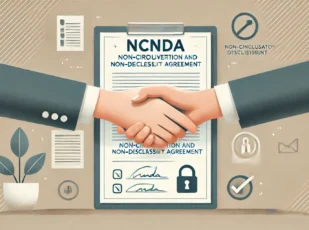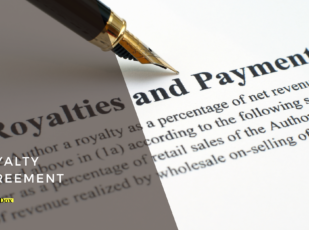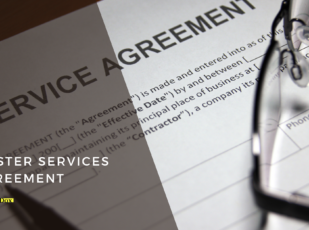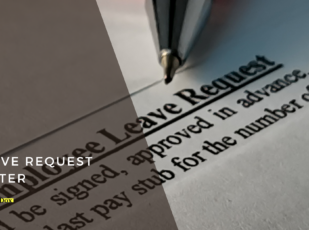
Collaboration Agreement Template
13 Downloads
Commercial, Corporate
February 17, 2025
Sayantani Dutta
There are three key drivers of the modern corporate economy—leveraging complementary strengths, expanding market reach, and creating an environment that encourages innovation. The business world of today relies on these pillars to develop groundbreaking solutions to humanity’s problems and improve their bottom line and profits. At the heart of it all are partnerships and collaborations.
A single organization can only do so much. The whole process of onboarding the right talent and forming well-rounded teams can be extremely expensive and very time-consuming. It is remarkably better, faster, and more efficient to just partner with another business, company, agency, or organization that has specialists with a proven track record.
That is what makes partnerships, collaborations, joint ventures, etc. so much in demand and ultimately successful. These initiatives can launch a product, let’s say, much sooner than an organization trying to do everything from the R&D, marketing, and production to sales on its own with dedicated employees/teams.
The Collaboration Agreement is an indispensable tool here. It outlines the framework for these cooperative ventures, details the terms of the partnership (such as the roles and responsibilities of each party), clarifies the goals of the collaboration, legally stipulates the allocation of resources, and offers the terms for handling profits and intellectual property. It is a legal document that also protects all parties in case any disagreements arise.
Why is a Collaboration Agreement Important?
The Collaboration Agreement can preemptively resolve potential misunderstandings and conflicts by setting clear expectations for all involved parties. Furthermore, it helps define the scope of the collaboration. It is very important to have clear guidelines and expectations in collaborative projects. The Collaboration Agreement ensures that everybody knows their responsibilities and what the expected outcomes are, so there are no ambiguities, confusion, or misunderstandings that could lead to disagreements, dissatisfaction, or even legal disputes down the line.
On the other hand, having a Collaboration Agreement is also important to protect any confidential information and intellectual property rights. For example, who will own which creative output? How will the rights or IPs shared among the collaborators? Which deliverables are going to be owned by the venture/collaboration itself, and not individually? All this needs to be specified.
Additionally, when you are getting in a collaborative project, you also need various types of written consents, warranties, dispute resolution or arbitration clauses, disclaimers about resource allocation, indemnity of the partners from unforeseen events, roadmap/guidelines for adding additional parties or removing existing parties, rules for choosing subcontractors, and so much more.
All of this cannot happen over a poorly drafted, generic Collaboration Agreement or verbally. You need a lot of protections under the governing law for the clauses to be enforceable—and the Collaboration Agreement helps you achieve precisely that. This entire agreement covers all legal bases and important clauses that protect the project and its parties while ensuring everything happens smoothly without any hassle.
With the clarity you get based on all the terms and conditions held within a comprehensive Collaboration Agreement for your project/venture, you can prevent disputes over a large variety of subject matters—resource allocation, intellectual property rights, and profit sharing, most importantly. These issues often derail projects and damage relationships. That is why a well-structured agreement ensures all parties of timely and efficient work, while also reassuring them of their protection under the agreement for greater openness and long-term collaboration.
Under the applicable laws, you must have a Collaboration Agreement to make sure a collaborative project is not derailed, delayed, or marred with inconvenient disagreements. If things were happening within an organization with existing employees or teams, you would not need so many protections. But for that faster speed and increased efficiency, you need to lay down solid groundwork first—the Collaboration Agreement is just that.
Collaborating Without Agreements: Recipe for Disaster
If you are starting a joint venture with:
- No Collaboration Agreement,
- Any other type of agreement created based on typical contract templates, or
- A free Collaboration Agreement based on a generic template,
You are risking everything—including the success of the project itself. All parties are exposed to significant risks including legal repercussions and delayed deliverables in these cases. One party might not make payments on time, another party might not abide by the weak non-disclosure agreement clauses, Party A might not respect Party B’s or another party’s rights, and so on.
A good partnership agreement is a basic necessity for projects like these. You should have legal recourse and severability to the extent necessary. And the provisions of this agreement help you do exactly that.
Every term of this agreement is intended to protect the parties, ensure proper work as per the timelines, ensure efficient workflow without any disputes, and ensure an overall transparent working environment for the success of the collaborative project or venture. This protects the business relationship between all parties and any venture stakeholders. Most importantly, a robust and legally sound Collaboration Agreement helps you prevent hiring expensive law firms for their legal advice that can arise out of weakly drafted agreements.
Here are some common issues that happen in case there is no solid Collaboration Agreement for a project:
- Without clear terms, collaborators may have mismatched expectations and misunderstandings about project goals and individual contributions. This often leads to conflicts and inefficiencies.
- Handling intellectual property can become contentious and lead to legal disputes if there is no formal agreement.
- The lack of a defined framework can also complicate financial arrangements, such as profit sharing and funding responsibilities, further straining the partnership.
Of course, you do not want any of that.
The Key Elements of a Collaboration Agreement
Alright, now, let’s take a closer look at what makes a good Collaboration Agreement. So far, we talked about the importance of a comprehensive agreement and the risks of an inadequate one. But that does not tell us what actually makes a legally sound and comprehensive Collaboration Agreement.
Typically, the exact contents of the agreement will depend on the nature of the work being done. It will also depend on other factors such as the organizations or businesses that are joining hands or the timelines of the project. However, overall, there are some key sections you will find in all Collaboration Agreements.
- Purpose and Scope: First of all, the Collaboration Agreement will define the goals and boundaries of the collaboration. Being clear about these things is fundamental to the efficiency of the project. Ultimately, you should aim to make sure that all parties are aligned with a common purpose.
- Roles and Responsibilities: Next, in the roles and responsibilities section, you will outline what is expected from each party in terms of contributions and effort. This essentially clarifies the duties to prevent overlap and ensure coverage of all critical areas.
- Financial Arrangements: Financial arrangements include the details on how costs, profits, and losses will be shared among the parties. This includes any funding commitments that have been agreed upon.
- Intellectual Property Rights: The IP rights section specifies the ownership, use, and distribution of any intellectual property developed during the collaboration. A lot of creative work might be created during the project/venture. If it will not be owned by the company entity itself, then you should specify who will own it, exactly.
- Conflict Resolution: Lastly, you also need to establish clear methods for resolving disagreements. A positive and productive relationship is everyone’s expectation when they start collaborating, but things do happen that can sour the experience. So, it is important to have proper conflict resolution clauses in place before you begin collaborating on a project.
Collaborate Better & More Efficiently with FreshDox.com!
Looking to draft a proper Collaboration Agreement that is comprehensive and legally sound? Well, you have come to the right place! FreshDox.com offers a well-structured Collaboration Agreement Template to make the process less complex and faster, especially for business owners or managers without legal expertise. We offer a wide range of legal document templates, including our professionally crafted Collaboration Agreement Template, designed by experienced lawyers familiar with the nuances of partnership dynamics across various industries.
When you sign up as a member of FreshDox.com, you gain access to all of our high-quality legal and business-related document templates in both PDF and Word formats. You can easily customize these templates to meet your specific partnership needs!
Also, FreshDox.com has a 14-day trial period. You can use it to explore the benefits of our Basic and Premium Plans. Basic Members can download up to three legal document templates per month, while Premium Members enjoy unlimited downloads. The Premium Plan is ideal for legal professionals or businesses engaged in frequent collaborative ventures.
Wait no more!
Streamline the process of forming partnerships and ensure that all aspects of your collaboration are legally sound with FreshDox.com’s Collaboration Agreement Template. Register today to start drafting your agreements with confidence and protect your interests in every partnership.
Related Templates
Discover more templates that align with your needs and preferences.

Ready to Sign Up?
Sign up for FreshDox.com’s 7-day trial and discover why so many individuals and businesses trust us for their legal document template needs.
- Cancel any time
- 7-day free trial
- From 300+ Customer Reviews

